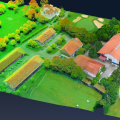
Uh oh! It’s not the first time, and it probably won’t be the last, but the Gothamist has pointed us to the tale of a Jersey man trusting his GPS over his gut, and using it to navigate in foggy conditions. This obviously led to disaster, when his car (and family) ended up driving into a house. I wish I could say that nobody was hurt during the incident, but the driver’s wife and 13 year old daughter weren’t wearing seatbelts, so suffered head and neck injuries. He and his son were wearing seatbelts, however, and were unharmed.
ArcNews have a post outlining the world’s largest book – a 120kg, 183 x 137cm atlas created by Sydney publisher Millennium House. How much does this 31 copy, limited edition atlas cost? Oh, only about $100,000.
Google Earth Blog have a fascinating visualisation of the Earth as it moved through the last glacial maximum up to today. You can see the glaciers ebbing and flowing, and eventually melting away as the temperatures accelerate up to the year 3000. They also have a second visualisation that begins today, and shows glacial and sea-levels as they may look up to the year 10,000.
LiDAR News point us to a paper that outlines a methodology for detecting change in buildings using aerial photography and LiDAR. This type of change detection has been used by the Ordnance Survey in England to increase tax revenue by identifying property owners who had not obtained building permits for new structures, and were thus not getting taxed.
For those futurists out there, the ever-entertaining O’Reilly Radar has a post talking about the next, next big thing. It’s basically proposing that we should look to history before believing the hype that any one technology is the “next big thing”.
LiDAR News makes a second appearance in BoB this week, with a post outlining a wheelchair for the blind that uses a 3D laser scanner to map the coming path, and provide haptic feedback to the user through a gently vibrating joystick. The last part of that sentence feels a little dirty, and for that I apologise.
The map room has a great shot showing how clear the tracks from the recent Southeast US tornadoes are in an ASTER visible-infrared satellite image.







